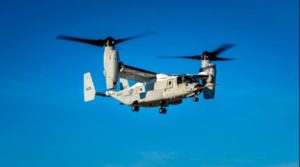The first CMV-22B Osprey for the Navy completed its first flight operations, the manufacturer said Tuesday.
The tiltrotor CMV-22B conducted flight operations at the Bell Amarillo Assembly Center in Texas. Built by a consortium of Boeing [BA] and Bell Textron [TXT], it is the third variant of the Osprey design, after the CV-22 used by the Air Force and MV-22 used by the Marine Corps.

The Navy plans to use the CMV-22B to replace the C-2A Greyhound to transport personnel, mail, high-priority cargo, and supplies from shore bases to aircraft carriers.
The C-2A has been in use since the 1960s with a strong safety record, but after one crashed into the Philippine sea in 2017 the Navy said it planned to accelerate its transition from 2027 to 2024 (Defense Daily, Jan. 16, 2019).
The Navy expects to reach initial operational capability for the CMV-22B with three aircraft in 2021 and reach full operational capability in 2022.
The Bell Boeing team noted it designed this variant for carrier operations by adding increased fuel capacity for the extended range requirement.
“With the ability to travel up to 1,150 nautical miles, the CMV-22B will be a lifeline for our servicemen and women out at sea,” Kristin Houston, vice president, Boeing Tiltrotor Programs and director, Bell Boeing V-22 Program said in a statement.
“The quality and safety built into this aircraft will revolutionize the way the U.S. Navy fulfills its critical carrier onboard delivery mission,” she added.
A Naval Air Systems Command (NAVAIR) factsheet notes the CMV-22B will provide the Navy with increased capability and flexibility over the C-2A. Compared to the Marine’s MV-22B Osprey, this model has a longer extended operational range, beyond line-of-sight HF radio, improved fuel dump capability, public address system for passengers and improved lighting system for cargo loading.
NAVAIR said the CMV-22B will be capable of transporting up to 6,000 pounds to 1,150 nautical miles. The program of record projects 48 total aircraft but the Navy currently plans to procure only 44 aircraft.
Chris Gehler, Bell V-22 Vice President and Bell Boeing deputy program director, said this flight “marks a significant milestone” for the V-22 program.
“The Osprey has always been a revolutionary aircraft, and we look forward to continuing to support the evolving needs of the Navy with advanced tiltrotor capabilities,” Gehler continued.
Bell Boeing plans to deliver the first CMV-22B to Air Test and Evaluation Squadron (HX) 21 in early 2020 for developmental testing.
This test comes after Boeing opened a new facility outside Philadelphia in August that will house fuselage production for new V-22s, including the Navy models (Defense Daily, Aug. 1).
Work on the CMV-22B variant was originally awarded to the companies as part of a $4.2 billion contract in June 2018. This included acquisition of 39 CMV-22Bs for the Navy (Defense Daily, July 2, 2018).
The Navy established the first CMV-22B squadron in December 2018 at Naval Base Coronado, Fleet Logistics Multi-Mission Squadron (VRM) 30, with the first aircraft planned to deliver in FY 2020. (Defense Daily, Dec. 20, 2018).